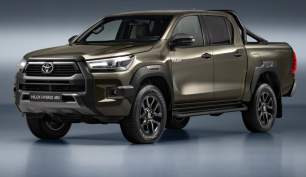This would make a great family weekend escape machine, for which BMW quotes a 645kg payload rating. It’s also rated to tow up to 2500kg of braked trailer, which could pose a challenge given the relatively low 100kg tow-ball download limit (TBD is typically around 10 per cent of trailer weight).
BMW also does not publish a GCM figure (how much it can legally carry and tow at the same time) so we can’t confirm if it can carry its maximum payload while towing its maximum trailer weight.
Even so, the M50 has a useful-sized luggage area which offers up to 570 litres (or 0.57 cubic metres) of load volume with the rear seat upright.
This expands to 1700 litres (or 1.7 cubic metres) with the rear seat folded flat, which can be handy for a multitude of tasks like transporting a mountain bike or hauling home flat-pack furniture.
There’s comfortable space for the driver and front passenger, along with useful storage including large bottle-holders and bins in each front door.
The centre console has two small-bottle/cupholders plus wireless phone-charging and a pair of USB ports. There's also a glove box plus another box at the rear of the console with a padded lid that doubles as an elbow rest.
The rear bench seat is surprisingly spacious, given that I’m 186cm tall and when seated behind the driver’s seat in my position I still have about 40mm of knee clearance, which is optimised by the concave shape of the front seat backrests.
The spacious and airy feel is enhanced by the ‘panorama’ glass roof which spans the full length of the seating area and allows generous headroom even for tall people.
However, shoulder room is tight for three adults and the centre passenger’s feet must contend with the transmission tunnel, so even though it would be fine for three kids we’d suggest a limit of two adults for longer trips.
Rear passengers get privacy glass and pull-up roller sunshades, large-bottle holders and bins in each door plus net-type pockets and anchorage points for media devices on each front seat backrest. There are also two small-bottle/cupholders in the fold-down centre armrest.
The rear of the centre console has two USB ports, adjustable air-vents plus controls for zone temperature, airflow preferences and seat-heating.
The bench seat features a 40/20/40 split, which allows the centre backrest to fold forward independent of the two outer backrests to allow long loads like snow skis, home hardware etc to be carried if securely fastened.
A power tailgate provides access to the luggage area, which is equipped with a handy 12-volt accessory socket plus load-anchorage points front and rear, extra storage nooks for small items on either side and a retractable roller-type load cover. Overall, this vehicle offers good practicality for family duties.

